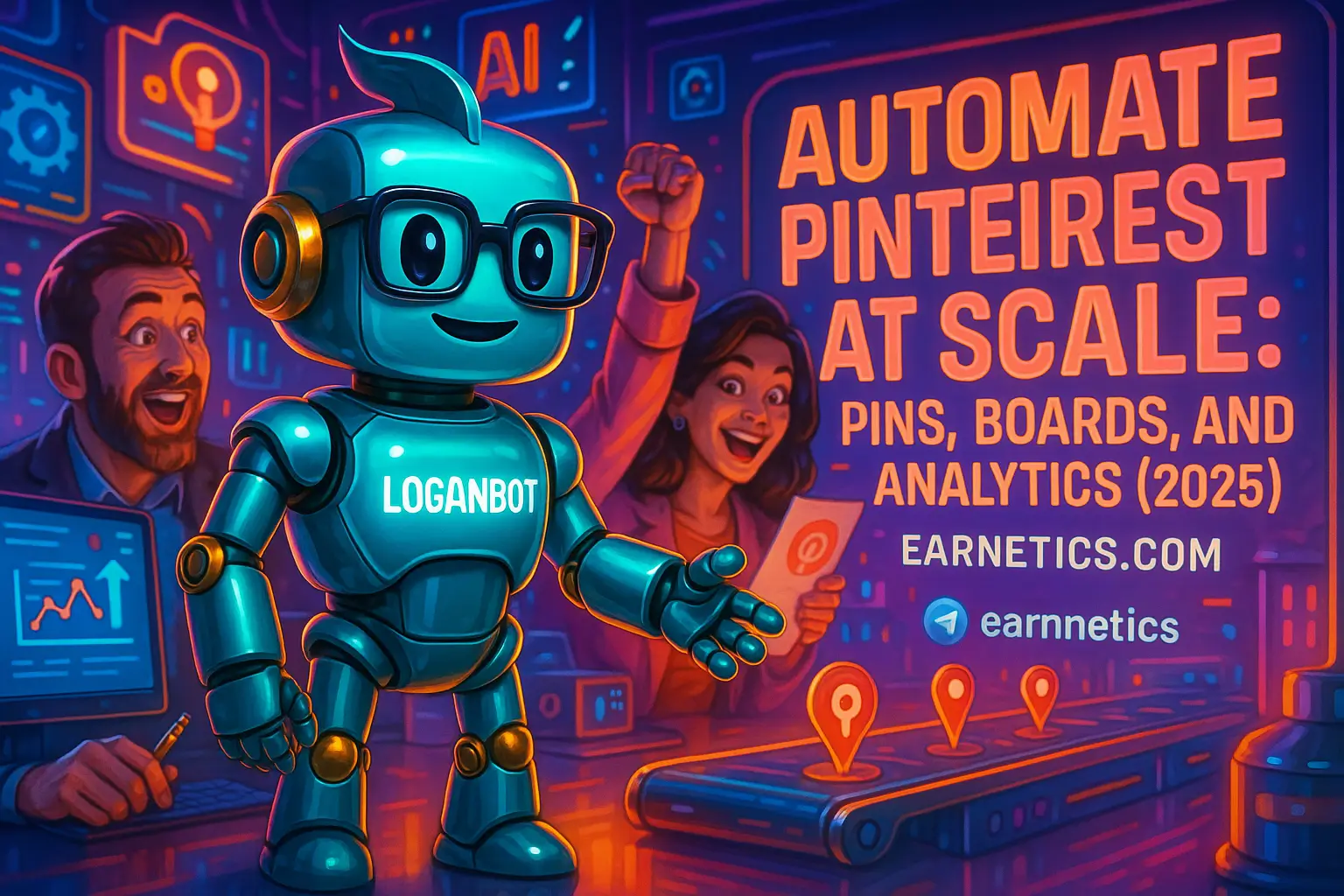Automate Pinterest at Scale: Practical Playbook for Pins, Boards, and Analytics (2025)
Automate Pinterest at Scale to save time, increase reach, and measure ROI with Pins, Boards, and Analytics – a practical 2025 playbook for creators and ecommerce teams.
I remember the first time I tried to manually pin 50 products a day. My neck hurt, my keyboard blamed me, and the results were meh. That’s exactly why I learned to automate Pinterest at scale. The goal was simple: stop doing repetitive crap, publish more high-quality variants, and actually measure what drove sales instead of guessing like a drunk DJ at a wedding.
In this guide I cover the full stack you need in 2025: tool choices and API strategy, creative and scheduling automation, board governance and catalogs, plus analytics and safety practices so your automation doesn’t blow up your account. By the end you’ll know how to wire product feeds into dynamic pins, run algorithmic scheduling, auto-manage boards, and build dashboards that tell you which creative makes money.
Quick keyword map for SEO sanity: secondary keywords: Pinterest automation tools, Pinterest scheduling, Pinterest board management, Pinterest analytics tools, Pinterest API, Pinterest catalog automation. LSI phrases: pin templates, dynamic pins, product feed sync, UTM tracking, conversion API, catalog feed errors, content cadence, creative variants, algorithmic scheduling, bulk upload.
This is for small teams, agencies, ecommerce stores, and social squads who want to scale smarter. If you implement the steps I used, you’ll stop babysitting pins and start running experiments that actually move the needle. Ready? Let’s get nerdy and practical.
Choose the Right Tools & API Strategy
Picking the right tech stack is the moment you stop guessing and start automating Pinterest at scale for real. I spent weeks swapping platforms, and here’s what mattered.
Official API vs third‑party platforms
The official Pinterest API and webhooks are your go-to when you need high control – catalogs, dynamic creatives, real-time inventory sync, and scale. I used the API when I needed product IDs tied to shopping pins and when I wanted event-driven updates instead of clumsy nightly batches. Official endpoints give you reliability and features, but they have rate limits, documentation quirks, and require dev upkeep.
Managed schedulers like Tailwind, Later, and Buffer are faster to launch with and great for content cadence, but they trade some control for convenience. If you want team-friendly dashboards and simple scheduling without engineering, start there. If you need catalogs, dynamic ad creatives, or complex feed remediation, plan on the API.
For Pinterest developer docs and exact API limits, I checked Pinterest’s docs regularly to avoid surprises: https://developers.pinterest.com/docs/api/.
Low-code integrations and automation platforms
Not every team has a dev backlog. I used Zapier and Make for quick wins – auto-create pins from new Shopify products, publish blog posts as pins, or tag content when an inventory alert fires. For heavier lifting I wired serverless functions (AWS Lambda) to batch process image overlays and push catalogs.
Use Zapier/Make for triggers and lightweight transformations. Use serverless for image composition, large CSV processing, and durable retries. My favorite trick: use a webhook to trigger an image-generation job, then push a finished image and metadata into the API for immediate publishing.
Tool selection checklist for 2025
When I evaluate tech I run them through a checklist: API access, bulk upload, image processing, template/variant support, analytics export, team collaboration, security. If a vendor slips on analytics export or no bulk API, I don’t trust them for scale. Prioritize platforms that let you export raw events so your BI layer can run wild.
Automating Pins: Creation, Scheduling, and Variants
Automating pins is where the magic – and the ROI – happens. I turned a handful of product images into hundreds of variants that fed both organic and ad pipelines.
Scalable content templates and dynamic pin generation
I created visual templates and fed them CSV/JSON with product images, headline text, prices, and locale copy. A design API rendered unique images on demand, so I could generate localized pins without hiring a designer for each SKU. This approach let me test price overlays, badges, and different CTAs at scale.
Tools I used: headless creative APIs, lightweight image processors in Lambda, and a template layer that accepts variables. That combo saved hours and kept brand consistency across hundreds of pins.
Smart scheduling and cadence at scale
Pinterest scheduling is no longer set-it-and-forget-it. I used algorithmic scheduling in platforms that learn best time windows, but I also ran controlled experiments with fixed calendars. The hybrid approach worked best: let the scheduler pick non-peak slots, and reserve prime times for A/B test winners.
Batch pins into themed campaigns, rotate variants every few days, and automate holdout groups so you can measure lift. I set my scheduler to avoid pinning identical creative more than twice in 48 hours to reduce duplication penalties.
Pin metadata and SEO automation
Titles, descriptions, alt text, hashtags, and links are not extras – they’re search signals. I built keyword templates and dynamic insertion rules so each pin got a unique title and description based on product attributes. UTM patterns were auto-generated per campaign so my analytics could attribute traffic without manual tagging.
Automate alt text for accessibility, but always review high-volume categories manually to catch tone and nuance. A little human polish goes a long way.
Automating Boards and Catalogs
Boards and catalogs are the scaffolding that keeps your pins discoverable. When I automated board management, search traction improved and operational chaos dropped.
Auto‑organizing boards and bulk board actions
I used rule-based systems to assign pins to boards by tag or product category. If a product tag said “summer-dress”, automation would add it to the appropriate seasonal board. That let me enforce naming conventions for SEO and archive or merge older boards programmatically.
Bulk board actions are a lifesaver when you rebrand or restructure. I once merged five underperforming boards into a single curated board overnight without a single manual drag-and-drop.
Product catalogs, shopping pins, and feeds
Catalog automation is non-negotiable for shops. I synced Shopify product feeds to Pinterest Catalog and automated daily updates for inventory and pricing. I also built monitoring that scanned feed error reports and triggered remediation workflows when a SKU failed validation.
Using product ids in pins let me serve dynamic shopping pins and tie them directly to ads. That closed the loop between content, catalog, and conversions.
Team workflows & permissions at scale
Automation without governance is a riot waiting to happen. I set up approval pipelines so drafts hit a queue, a human reviewer gave the green light, and then the system published. Audit logs tracked who changed what, and role-based permissions prevented junior members from publishing cataloged shopping pins without review.
For multi-account management, a single orchestration layer that maps teams to accounts saved me from the “who posted that” blame game.
Analytics, Attribution, and Reporting Automation
Automation without measurement is just noise. I automated the data flow so decisions were evidence-based, not vibes-based.
Key metrics to automate for
I tracked impressions, saves, closeups, clicks, conversions, and ROAS. The Pinterest Tag plus Conversion API and UTM-tracked landing pages let me stitch multi-touch journeys together. I always feed raw events into GA4 and my BI layer so I could do cohort and funnel analysis.
Building automated dashboards and alerts
I scheduled exports from Pinterest, pushed them into BigQuery, and built dashboards in Looker and Data Studio. Alerts for traffic drops, feed failures, or a sudden dip in save rate saved campaigns from going off the rails. Anomaly detection flagged when a catalog went from healthy to error-prone so I could fix it before revenue dipped.
Measuring impact of automated creative at scale
Automate lift tests: split traffic, rotate creative variants, measure conversions, and auto-promote the winners. I ranked creatives by conversion rate and set the system to bias distribution toward top performers. This lets you scale what works while still exploring new ideas.
Safe Scaling: Compliance, Rate Limits & Best Practices
Scaling fast is fun until the platform suspends you. I learned to build guardrails so automation looks human, not spammy.
Policy compliance and anti‑spam measures
Respect Pinterest’s developer terms and content policies. Don’t flood boards with duplicated pins, and avoid automation patterns that mimic abusive behavior. I built duplication checks and enforced minimum differences between variants so the platform didn’t flag my account.
Rate limits, backoffs and robust error handling
APIs have quotas. I implemented exponential backoff, batching strategies, and retries. When Pinterest returns a rate error, the system pauses and requeues tasks instead of hammering the endpoint. That reduced errors and kept operations smooth.
Ethical automation and user experience
Automation should amplify human strategy, not replace it. I kept creative quality high, enforced alt text for accessibility, and prioritized relevance. If an automated pin performed poorly, I’d pull it and inspect why instead of blindly scaling it because it met a metric.
Conclusion
Automate Pinterest at Scale by choosing the right mix of API access and third-party tools, automating pin creation with templates and dynamic variants, organizing boards and catalogs programmatically, and instrumenting analytics so every move is measurable. I went from manual pin churn to a system that autosuggests winners and scales them without me staring at a dashboard all day.
Quick implementation checklist you can copy today: 1. Choose your stack – pick API-first if you need catalogs, or start with a managed scheduler for quick wins. 2. Pilot one workflow – auto-create 20 product pins from a catalog. 3. Set up tracking – Pinterest Tag, UTM patterns, GA4. 4. Build a dashboard – daily health checks and variant performance. 5. Add compliance safeguards – duplication checks and rate limit handling.
The ROI is real. Automation cuts manual cost, increases content velocity, and unlocks continuous optimization through variant testing. But don’t confuse speed with scale – iterate in small pilots, centralize observability so you spot issues fast, keep creative quality high, and stay aligned with Pinterest policies so you don’t trade growth for a suspension.
Final tips from my messy learning curve: automate the boring parts, guard the creative parts, and treat your catalogs like inventory – imperfect automation will ship broken listings fast if you don’t monitor them. Start small, measure everything, and scale what wins.
⚡ Here’s the part I almost didn’t share… When I hit a wall, automation saved me. My hidden weapon is Make.com – and you get an exclusive 1-month Pro for free.
✨ Want the real secret? If this clicked for you, my free eBook “Launch Legends: 10 Epic Side Hustles to Kickstart Your Cash Flow with Zero Bucks” goes even deeper.
Explore more guides and tools to build your digital income empire today on Earnetics.com.


